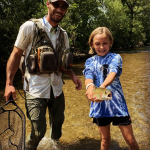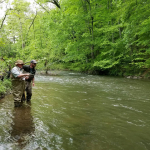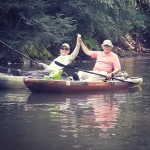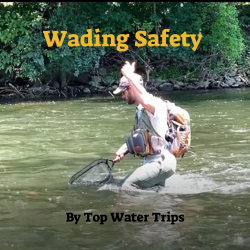
Wading Safety
In our Fly Fishing Lessons, we teach a lot about Wading Safety & Equipment as it is a vital part of Fly Fishing that is not talked about enough…So, here are some starting points to what we teach here at Top Water Trips.
Picking Crossing Locations
When picking crossing locations the primary goal is safety.
Tailouts
-
- Tailouts, the bottom/shallow end of a pool, is a great location to cross. But, be careful in tailouts because they usually constrict back into runs/faster currents just below them.
- Find Wide & Shallowest Areas
- Look for Potential Entrapments
- When Choosing Crossing Locations look downstream for potential entrapments- Down Trees, Logs, Big Boulders…
- If entrapments are close downstream consider picking another section to cross
- Have a destination– Choose the spot you would ideally like to land upon. When crossing, it is best to start your cross upstream from your desired endpoint. Wading at a 45 Degree angle across the stream will save energy and is safer than trying to wade straight across.
Wading Safety Tips
Getting Stuck & Crossing Through Mud
Mud & sediment deposits in eddy’s are expected and crossing through them often feels scarier than it actually is. But, mud & sediment still absolutely present potential hazards, and should be respected when it comes to Wading Safety. A wading staff will be a very friendly tool in Mud scenarios. Use your wading staff to indicate how deep the mud is to make your decision.
How to get out of the mud
- Break the Suction by bending your knee, lifting your heel up, and raising your foot out of the mud.
- If you choose to continue wading through the mud and find yourself not able to break the suction, we need to disperse our weight, because it’s our weight that is keeping us stuck in the mud.
- A wading staff will come in handy here to help give you an additional point to lean and get your foot out
- So, taking long strides, dispersing the weight, keeping our heels up & toes down will help us wade through the mud to the other shore
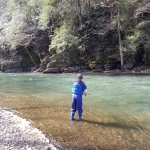
Buddy Wading & Deep Water Wading Safety
Condensed Instruction to Buddy Wading
- Upstream Person and upstream arm should be carrying the rods
- Downstream Person should manage the wading staff with their downstream arm creating an additional point on contact
- Middle Arms holding onto wading belts to increase stability, when linking arms or holding onto each other, make sure to never hold somewhere you may get stuck or tied together. If one goes down and the other is locked in or stuck together, both will go down. So, be aware of loose hanging gear or potential items that could cause you to get unintentionally tangled.
Deep Water
- If the water becomes too deep and crossing is still in mind, bounce off the bottom with your tippy toes to propel yourself through the water, using your natural buoyancy to get you across
- If you reach the Point of No Return… Begin to back yourself out if possible, wading & crossing should be done to the point where you feel comfortable.
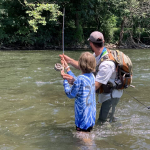
Swimming In Waders
There are many misconceptions when it comes to swimming or going down in your waders. It is a great practice to attempt swimming in your waders in a safe location with a friend. Getting a feel and understanding of what happens when your waders fill with water and you need to swim in them will help during a real situation. Learning that there is no need to panic will help you in making the right decisions in case of a real fall.
- If your Waders fill with water, don’t panic- while you’re in the water in your waders is essentially weightless and won’t drag you down.
- Do not try to remove your waders in the water
- While not impossible, it is exhausting and dangerous to do. The amount of energy necessary to do this could endanger your life
- Look for the nearest bank and begin to swim, if you have your rod in hand, backstroke your way to the bank
- Once on shore immediately empty your waders and attempt to ring out, dry your clothes. Mild hypothermia can set in relatively quickly even in non-freezing environments.
Handling Fast Water
Sometimes, wading through swift current is unavoidable, especially when it might lead to an excellent fishing location. Or, maybe you hooked into a large fish and he’s taking you downstream into a faster current and you don’t want to lose the fish, either way, there are proper ways to handle & wade fast water.
- Wade Sideways & shuffle your feet
- Water is always fastest near the surface, the friction of the river bottom slows down the current.
- So, when wading in fast water it is best to keep your feet close to the bottom when shuffling across. Picking up your feet too high in fast water can create a sweeping effect and cause a slip.
Going Down In Fast Water
- If you go down in fast water, our first goal is to get our feet downstream and position ourselves on our backside. Try to avoid standing up if you can until you find a softer spot of water. Trying to stand immediately after a fall in fast current is possible but dangerous because it creates the opportunity for potential foot entrapments. If you go down in fast water, don’t panic, position yourself properly and keep an eye out for log jams & potential entrapments.
River Hazards & How to Handle Them
Log Jams, Pins & Strainers
Strainers & Log Jams are some of the most dangerous elements of wading after a fall. A Strainer is a down tree with branches underneath the surface that collect objects in a Sieve-like manner. Strainers with strong currents pushing up against them can kill. If you go down in fast current and get caught underneath a log in the branches of a strainer you can potentially lose your life.
What to do when approaching a Log Jam or potential Strainer after a fall
- Do not try to swim underneath the log
- Do not let your legs get caught underneath the log and your chest pinned up against the log, the force and strength of the current will make it near impossible to get yourself unpinned
- If you do find yourself in this position, try to get one leg back behind the log with your foot. Then pushed up against the log for leverage to get your other foot behind the log. This is an exhausting and potentially fatal technique. You should never find yourself in this position if you approach the log properly and do not allow your legs to get stuck underneath with your chest pinned
- If you are approaching a down log after a fall that has strong current pushing up against it best practices & experience indicate that you flip onto your stomach with your head downstream and swim aggressively toward the log. Upon approach, use the momentum of the current and swim right over the top of the log.
Undercut Banks, Ledges & Drop-Offs
These river features offer great fish habitat & hiding locations but also present potential dangers to Waders/Anglers. Ledges, or shelves, in many cases are great places to wade, stand on, & fish. But, they are also very easy to step off of. Undercut banks, especially outside bends, are constantly eroded by moving water and in this process that bank becomes undercut & can create an entrapment.
A great pair of sunglasses can save you from stepping off Ledges & Drop-Offs. Another useful tool for recognizing these drop-offs is to understand watercolor. Learning to equate/compare Water Color & Depth. Typically, the deeper the color the deeper the water. You can see this by looking at shallow water and how it’s relatively colorless in comparison to deeper holes and runs. But, depth and color aren’t always consistent, especially in the clearest of waterways. Waterways with the highest clarity make it difficult to recognize depth, so be careful in streams that have high clarity.
In Conclusion
So, this concludes our long intro to Wading Safety & Wading Hazards that is part of our upcoming textbook set to come out in Spring 2021. We have a lot more information & tips included in our upcoming pamphlets & textbooks so be on the lookout as we start to roll out bits and pieces of it!

